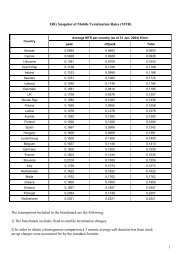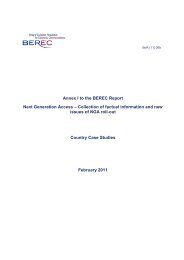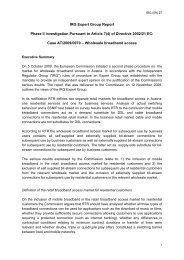16 Rev2b NGA Opinion Supplementary doc - IRG
16 Rev2b NGA Opinion Supplementary doc - IRG
16 Rev2b NGA Opinion Supplementary doc - IRG
You also want an ePaper? Increase the reach of your titles
YUMPU automatically turns print PDFs into web optimized ePapers that Google loves.
ERG (07) <strong>16</strong>rev2b <strong>NGA</strong> <strong>Opinion</strong> <strong>Supplementary</strong> Doc 37 / 69<br />
Framework and is co-funded at 70% by the European Fund for Regional Development<br />
(EFRD) and at 30% by national funds.<br />
In general, the development in broadband access in Greece, is characterized by an increased<br />
interest for private investments. As mentioned by the telecom providers in the 8 th<br />
Info-com (Athens - October 2006) conference, many of them have a number of active or<br />
planned infrastructure investment projects, especially in the field of fibre optics ducting.<br />
These projects are located in the two main urban areas of Greece (Athens and Thessaloniki)<br />
and their aim is to develop alternative high speed backbone optical networks at the core<br />
level. It is important to mention that during the conference, many of the alternative operators<br />
who are actively involved in these projects, estimated too high CAPEX for fibre optics ducting<br />
investments and expressed their desire to cooperate with others in order to share the associated<br />
risk.<br />
Despite the above mentioned evolution, as answered in the relevant fact finding questionnaire,<br />
the NGN and the IP interconnection does not seem to be a relevant problem today.<br />
EETT has conducted public consultation (June 2006) on VoIP with three questions related to<br />
IP interconnection. The opinion of all the market players, according to their answers, is that it<br />
is too early for the Greek telecommunication market to introduce IP interconnection, since<br />
both NGNs and VoIP services are in a very early stage of adoption.<br />
2.6 Italy<br />
During the meeting with the financial community held on 9 march 2007 Telecom Italia has<br />
announced its plans for the transition towards the NGN access network.<br />
The main points of such a plan can be summarized as follows:<br />
• Introduction of FTTB or FTTC architecture, based on G-PON technology and VDSL2<br />
from the Cabinet to the home. The above mentioned network innovation should be<br />
carried out gradually: the coverage will pass from 0,2% in 2007 to 5% in 2009, corresponding<br />
to 20 main cities. The coverage should reach 65%, corresponding to 1140<br />
cities, in the long term.<br />
• Adoption of FTTH in specific cases;<br />
• Extension of ADSL2+/3-play coverage from 51% in 2007 to 67% in 2009. The<br />
ADSL2+ coverage should reach a value close to 100% in the long term, with the introduction<br />
of about 8000 IP DSLAM.<br />
• A Capex of about 500 mln Euro is foreseen in the first phase (2007-2009). A Capex<br />
of 6,5 Bln Euro is foreseen for the full project.<br />
• Implementation of a full IP network.<br />
• Costs/Capex reduction thanks to efficiency of network (migration towards a single IP<br />
platform and reduction of the number of local exchanges)<br />
Other Key Project Figures:<br />
• 75.000 street cabinets, out of 145.000, equipped with VDSL2<br />
• 1.600 COs (Local Exchanges) releases/compatted<br />
• 60.000 Km of new fibre optics paths







